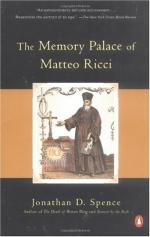
|
| Name: _________________________ | Period: ___________________ |
This test consists of 15 multiple choice questions and 5 short answer questions.
Multiple Choice Questions
1. To whom did the Chinese emperor leave many matters to be handled?
(a) Elected representatives.
(b) His appointed cabinet.
(c) Administrative eunuchs.
(d) Military generals.
2. Matteo Ricci lived during which period of time?
(a) The Medieval Period.
(b) The Enlightenment.
(c) The Reformation.
(d) The Renaissance.
3. What is the subject of Ricci's book that he wrote while in Nanching?
(a) An explanation of the Christian Bible.
(b) Agriculture and animal husbandry in the Chinese countryside.
(c) The teachings of the great members of Western civilization.
(d) Manners and behavior in Western cultures.
4. In the 16th century, who provided funds to Christopher Plantin to write his Bible?
(a) King Phillip II of Spain.
(b) Emperor Wanli of China.
(c) The people of Antwerp.
(d) King Henry VIII of England.
5. According to the charismatic Jesuit missionary, which group was amenable, "soft" like women, ambivalent about war and ready to do what they were told?
(a) The Indians.
(b) The Mongols.
(c) The Chinese.
(d) The Japanese.
6. Where had Ricci traveled throughout 1578?
(a) From Italy to Egypt.
(b) From India to Portugal.
(c) From Portugal to India.
(d) From China to Japan.
7. Which of the following did the Jesuits NOT do on the trip in 1578?
(a) Tended to the sick.
(b) Prepared meals for the passengers.
(c) Practiced their devotions.
(d) Heard confessions every eight days.
8. With whom were Macerata's rural poor fighting?
(a) City officials.
(b) The Catholic Church.
(c) Bandits.
(d) Landowners.
9. What kind of map did Ricci draw in 1584?
(a) A map of Europe with Chinese names.
(b) A world map with Chinese names for the countries of the world.
(c) A map of the New World for Jesuit missionaries set to travel there.
(d) A map of the Chinese seas with Westernized names.
10. What are mnemonic devices?
(a) Ways to remember by association.
(b) Ways to improve public speaking.
(c) Recording tools to transcribe notes.
(d) Auditory tools to improve people's hearing.
11. From whom did Ricci devise this memory method?
(a) The Renaissance playwright Christopher Marlowe.
(b) The Greek poet Simonides.
(c) The Greek poet Aristotle.
(d) The Roman poet Ovid.
12. Where did Ricci spend five years as an apprentice?
(a) Africa.
(b) India.
(c) China.
(d) Japan.
13. What did Matteo Ricci teach the Chinese people?
(a) How to build a memory palace.
(b) How to read the Bible.
(c) How to speak English.
(d) How to build better villages.
14. About what did Ricci's Chinese Christian converts complain?
(a) Repression from the government.
(b) Hostility from other Chinese.
(c) Inability to understand the papacy.
(d) Lack of Christian works, such as the Bible.
15. During the Renaissance, what was the focus of concern by the Jesuit missionaries in India?
(a) Jewish repression of Jesuit missionaries.
(b) Indigenous Christians and Nestorian heresy.
(c) Buddhist priests and anti-Christian sentiment.
(d) Government restriction on foreign missionaries.
Short Answer Questions
1. When did Ricci leave Macerata to study in Rome?
2. In what other way were mnemonic devices used during the 16th century?
3. According to "Chapter Four, The Second Image: The Huihui", what tenet was similar to the three major religions of China?
4. According to "Chapter Three, the First Picture: The Apostle in the Waves", to whom did Ricci give the first picture?
5. To what does Ricci compare a ship's pilot?
|
This section contains 549 words (approx. 2 pages at 300 words per page) |

|




